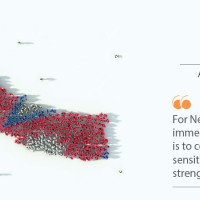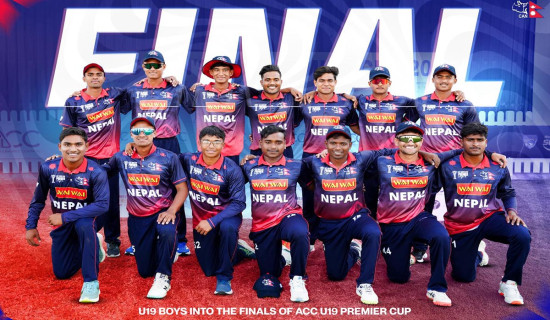- Saturday, 29 November 2025
Let Hearing-Impaired Pursue Higher Studies
Himal Guragain, a hearing-impaired boy, has been pursuing Bachelor’s Third Year course at the Central Campus for the Deaf in Naxal, Kathmandu. He had a wish to pursue information technology and commerce at Bachelor's level after completing the Plus-Two level. But his wish remained unfulfilled, as the curriculum at his college lacks these subjects. Moreover, no other colleges are offering more separate subjects deaf people like Guragain choose to pursue. This is the only college offering higher education to the hearing impaired. “At our college, there is only one curriculum that offers limited subjects. I wish to pursue information technology or accounting. But our campus curriculum lacks these streams,” he said. In a context wherein there are more than 100,000 words related to sign language and more than 5,000 sign language vocabulary, only a few schools and campuses in Nepal are offering limited subjects, according to him.
This has made matters worse for deaf people like him. “I had to visit Kathmandu, the federal capital, for higher education as my village or nearby towns lack a college offering education to hearing impaired people. It is difficult for us to sustain ourselves in Kathmandu. It is harder for those of them from poor families. We need scholarships." A lack of skilled and experienced teachers to teach particular subjects like information technology and account for hearing impaired people has been a matter of concern, he said.
Special Skills
“Teachers need a good command over sign language and special skills to understand facial expressions of hearing impaired people. But, most schools offering education to them lack skilled teachers. The school offers a curriculum of nine subjects, and 45 minutes are allotted for each subject. The fact is that around 90 per cent of students cannot understand what lessons are offered to them. It takes time for them to understand," he said. The current curriculum for hearing impaired people is not suitable, and they need another curriculum, he viewed. Rabita Deula who is studying at the same college is facing the same problem as Guragain.
They are facing difficulties due to a lack of skilled teachers and interpreters who translate their language. There are a total of 22 special schools and 174 integrated schools with resource classes across the country that are accessible to hearing-impaired people, according to the National Federation of Deaf Nepal (NDFN). These schools have 6,380 hearing-impaired people and 204 deaf and blind children, it said. But these educational institutions lack skilled and experienced teachers with knowledge of sign language, thus making it difficult for hearing and visually-impaired children, it said. Of the two types of persons with disabilities, deaf and blind children who either cannot hear and see or can partially hear and see require teaching through the special mediums of touch, taste, smell and movements. Those who are hearing impaired need to be taught through sign language and bilingual methods. According to the 2011 census, there are 88,743 hearing-impaired people in the country. The constitution of the country has guaranteed that each Nepali community has the right to get an education in their mother tongue, and educational institutions should be opened and run for them.
Similarly, laws have it that hearing and speech-impaired people have the right to free education through sign language. Article 32 of the constitution has it that each individual and community has the right to use their language. Schedule 8 of the constitution has a provision that basic and secondary level education falls within the purview of the local level. The constitution has also guaranteed compulsory and free basic education, free secondary education and scholarships for higher education.
The Act relating to Rights of Persons with Disabilities 2074 BS has a provision that differently-abled people, including hearing impaired ones, people with difficulty of hearing, and deaf and blind, should get education through appropriate language, script, method, curriculum and the use of information technology. The government has made arrangements for separate examination and evaluation systems based on the poverty, geographical difficulties and severity of persons with disabilities to provide education alongside boarding facilities for them, and for building disabled people-friendly educational materials, school buildings and physical structures.
But, a lack of access to these facilities, and their participation in learning have become a setback for them to get an education. Although private educational institutions are bound to provide free education to them as per the government’s decision, there is a problem with its implementation. The Act relating to the Rights of Persons with Disabilities and related Regulations, 2077 BS have guaranteed scholarship up to the Bachelor’s level for children of hearing impaired parents. The TheNational Medical Education Act of 2075 BS and Regulations, 2077 BS has also provisioned 10 per cent scholarships to marginalised communities.
Similarly, the Education Act, 2028 BS, the Education Rules, 2059 BS and the Act relating to Compulsory and Free Education, 2075BS have guaranteed facilitation in providing learning activities to hearing impaired children that are adaptable with the curriculum suitable for their learning needs, and educational activities. The NDFN has been demanding that hearing-impaired people should be provided with education through their medium language, and the availability of substantial vocabulary and grammar in sign language. Other demands are the management of interpreters for them in mainstream universities and their welcome and acceptance by them, the creation of an environment conducive to helping them learn, the development of inclusive culture, and access to technical and vocational education for them.
There are a total of 138 sign languages in use across the globe, and they are used in 300 different ways. Sign language was for the first time validated in the world in 1992. So far, 61 countries in their constitution, acts and regulations have given validity to sign language. The Language Commission in Nepal has recommended that the government promote sign language. According to the National Education Policy, 2076 BS, children with disabilities should get appropriate educational opportunities through special and inclusive education based on their needs and the principle of inclusiveness. It has provisioned scholarships, educational materials and other management for hearing-impaired children. The Federation General Secretary Santosh KC said factors like variation in ‘local sign language, failure to use substantial vocabulary in using sign language, thus disseminating otherwise message signalling subject codes by the speaker, and hearing related problems in learning activities have been a drawback.
Stating that words signalled are not substantial for higher education, Rishiram Devkota, who teaches at the Central College for the Deaf, stressed the need to make some available words meaningful. There should be no deviation in signalling words, and there should be a habit of using sign language dictionaries. Similarly, there should be clear pictorial signs in the dictionary, he viewed. There is minimal use of sign language in mathematics, science and social studies, he said. Similarly, there is the trend of accepting only sign language in learning and teaching methods, and the minimal use of visual materials and technology and learning and teaching activities online, according to him.
Sign Language
Although providing education to hearing impaired people has been accepted as their right, they are yet to get access to quality education due to society’s outlook towards them, a lack of required workforce for inclusive education and a lack of teachers’ readiness and efficiency to facilitate in learning and teaching activities, he said.
In Nepal, sign language was developed in 2037 BS after the existing Kathmandu Association of the Deaf was developed following the establishment of the then Deaf Club. The campaign to organise hearing-impaired people started after Italian tourists saw and identified a group at the hearing impaired people in Basundhara in Kathmandu, it is believed. Nepali sign language was developed on the initiatives of a community of hearing-impaired people. First published in 2052 BS, the Nepali sign language dictionary has seen its seventh publication so far, and there are 4,700 words in it. Some factors like a lack of the government’s initiatives to make any policies and rules regarding sign language and confusion in which the ministry is responsible to develop sign language, a lack of hearing impaired people’s friendly curriculum and the dependence on donors to provide training for related "Teachers have been a matter of concern, said the NDFN President Kedar Prasad Adhikari.
(The author is a journalist at RSS)

















